CFD Numerical Simulation of Slurry Flow Characteristics Under the Clogged Form of Coal Gangue Slurry Transportation Pipeline
Abstract
1. Introduction
2. Long-Distance Gangue Slurry Ring Tube Experiment
2.1. Test System
2.2. Introduction to Distribution
2.3. Comparative Analysis of Simulations and Experiments
3. Establishment of a Grouting Pipeline Blockage Model
3.1. Establishment of Gangue Pipeline Blockage Form
3.2. Establishment of Computational Models
- represents the shear stress tensor;
- μ denotes the shear viscosity;
- indicates the momentum exchange between the solid and liquid phases;
- represents the overall viscosity of the solid phase.
3.3. FLUENT Software Settings
- is the shear stress, in Pa;
- is the shear rate, in s−1;
- μ is the apparent viscosity, in Pa·s;
- τ0 is the initial yield stress, in Pa;
- n is the flow behavior index. When n = 1 and τ0 = 0, it is a Newtonian fluid;
- when n = 1 and, τ0 > 0, it is a Bingham plastic;
- when n > 1, it is a dilatant fluid;
- when n < 1, it is a pseudoplastic fluid.
3.4. Simulated Condition Settings
4. Analysis of CFD Simulation Results
4.1. Analysis of Simulation Results of Non-Clogging Conditions
4.2. Analysis of Simulation Results of Blockage Conditions
4.2.1. The Influence of the Degree of Blockage on the Distribution of Pipeline Characteristics
4.2.2. The Influence of Blockage Pattern on the Distribution of Pipeline Characteristics
4.2.3. The Influence of Blockage Location on Pipeline Pressure Distribution
4.2.4. Analysis of the Influence of Flow Velocity Under Blockage Conditions
5. Conclusions
- (1)
- The presence of blockage results in significant pressure and velocity gradients near the blockage point. As the blockage increases, so does the pressure gradient, particularly beyond 50%, where a strong correlation with blockage characteristics is observed. Similarly, the velocity gradient increases with the blockage degree, and the relationship between the velocity gradient and the blockage characteristics is also positively correlated. Therefore, by detecting the pressure drop at the pipeline’s starting point, initial velocity, and the sharp changes in the pressure and velocity distribution curves, it is possible to detect and locate the blockage.
- (2)
- The effects of the three blockage shapes on the internal pressure of the pipeline are ranked as follows: B-blockage has the greatest impact, followed by C-blockage, and A-blockage has the least impact. When the blockage degree is less than 50%, the changes in the pressure drop along the pipeline caused by the three blockage types are not significantly different. However, as the blockage degree increases, the pressure variations, particularly in B- and C-blockages, become more pronounced, with a larger fluctuation in the pressure along the pipeline. Among these, the B-blockage results in the most dramatic pressure changes. The formation of such blockages was analyzed in detail, and corresponding suggestions were proposed to address them.
- (3)
- In all three blockage types, the flow of slurry in the pipeline is characterized by distinct laminar flow, with the maximum flow velocity occurring at the center of the pipeline, forming a “flow core”. The velocity at the top and bottom is lower due to friction with the pipeline surface. Moreover, the blockage shape significantly affects the flow velocity and pipeline safety. The stagnant flow region (dead zone) area for B- and C-blockages is larger than that for A-blockage, underscoring the importance of timely blockage removal. To prevent blockages, it is recommended to use pipeline materials with smooth inner surfaces and low roughness.
Author Contributions
Funding
Institutional Review Board Statement
Informed Consent Statement
Data Availability Statement
Conflicts of Interest
References
- Zhu, L.; Gu, W.Z.; Yuan, C.F.; Liu, C.; Pan, H.; Song, T.; Sheng, F. Application and Prospect of Coal Gangue Slurry Filling Technology. Coal Sci. Technol. 2024, 52, 93–104. [Google Scholar]
- Zhu, L.; Song, T.Q.; Gu, W.Z. Research and Application of Coal-Based Solid Waste Slurry Pipeline Filling Technology. Coal Technol. 2021, 40, 47–51. [Google Scholar]
- Lile, N.L.T.; Jaafar, M.H.M.; Roslan, M.R.; Azmi, M.S.M. Blockage Detection in Circular Pipe Using Vibration Analysis. Adv. Sci. Eng. Inf. Technol. 2012, 2, 54–57. [Google Scholar] [CrossRef][Green Version]
- Kim, Y.; Simpson, A.R.; Lambert, M.F. The Effect of Orifices and Blockages on Unsteady Pipe Flows. World Environ. Water Resour. Congr. 2007, 157, 1–10. [Google Scholar]
- Adewumi, M.A.; Eltohami, E.; Solaja, A. Possible Detection of Multiple Blockages Using Transients. J. Energy Resour. Technol. 2003, 125, 154–158. [Google Scholar] [CrossRef]
- Zhao, L.A.; Xu, Z.L. Cause Analysis and Prevention Measures of Pipeline Blockage in Slurry Transportation. J. Liaoning Tech. Univ. Nat. Sci. Ed. 2009, 28, 10–12. [Google Scholar]
- Zhang, Q.L.; Wu, L.H.; Bian, J.W. Fault Tree Analysis of Filling Pipeline Blockage. Metall. Min. 2015, 44, 145–148. [Google Scholar]
- Han, X.J.; Li, X.S.; Dai, S.P.; Zhang, J.; Li, Z. Cause Analysis of Pipeline Blockage Caused by Instantaneous High Flow Velocity of Filling Slurry. Nonferrous Met. (Min. Sect.) 2016, 68, 19–22. [Google Scholar]
- Liu, F.M. Numerical Simulation of Flow Characteristics in Long-Distance Slurry Pipelines. Coal Mine Mach. 2018, 39, 129–131. [Google Scholar]
- Zhang, J.L.; Cheng, X.M.; Wang, G.Z.; Wu, Z.G. Study on the Causes and Countermeasures of Pumping Gangue Filling Pipeline Wear and Blockage. Coal 2013, 22, 6–8. [Google Scholar]
- Gu, W.Z.; Yang, B.G.; Gu, C.J. Study on the Adjacent Grouting Filling Technology for Gangue Slurry. Coal Technol. 2023, 42, 75–79. [Google Scholar]
- Yu, P.F.; Lei, Y.; Liu, X.; Zhang, L. Research on Pipeline Leak Detection Technology Based on Negative Pressure Wave Principle. Pipeline Technol. Equip. 2017, 5, 22–24. [Google Scholar]
- Liu, E.B.; Li, C.J.; Liu, X.D.; Peng, S.B. Research on Detection and Location Technology for Oil and Gas Pipeline Blockages. J. Harbin Inst. Technol. 2009, 41, 204–206. [Google Scholar]
- Zhang, Y.; Ma, Y.; Tian, F.Y.; Gou, Q.Y. Numerical Simulation of Flow Field in Condenser Core Tube Based on CFD. Mach. Tool Hydraul. 2020, 48, 90–96. [Google Scholar]
- Wang, J.L.; Xiong, Y.H.; Zhang, Y.Q.; Liang, H.; Wang, R. CFD Numerical Simulation on Blockage of Drainage Pipeline in Utility Tunnel. Sci. Technol. Eng. 2023, 23, 6607–6613. [Google Scholar]
- Zhang, D.D.; Chai, J.; Li, Y.; Sun, Y.Y. Strain transfer and engineering applications of fiber Bragg grating monitoring in loose layer settlement. J. Rock Mech. Eng. 2015, 34, 3289–3297. [Google Scholar]
- Wang, C.C.; Xu, J.L.; Xuan, D.Y. Research on the Blockage Mechanism of Ground Slurry Transport Pipeline Isolated by Overburden Grouting. Coal Sci. Technol. 2018, 43, 2703–2708. [Google Scholar]
- Song, B.K. Study on Pipeline Blockage Detection Method Based on Pressure Wave. Ph.D. Thesis, Yangtze University, Wuhan, China, 2019. [Google Scholar]
- Han, G.J. Fundamentals and Applications of Fluid Mechanics; Mechanical Industry Press: Beijing, China, 2012. [Google Scholar]
- Gan, D.Q.; Gao, F.; Chen, C.; Liu, A.X.; Zhang, Y.P. Numerical Simulation of High-Concentration Tailings Slurry Pipeline Transportation. Metall. Min. 2014, 10, 138–141. [Google Scholar]
- Shi, H.W.; Huang, J.R.; Qiao, D.P.; Teng, G.L.; Wang, B. ANSYS Fluent-Based Simulation Study on Ultra-Deep Well Long-Distance Paste Filling Pipeline. Nonferrous Met. (Min. Sect.) 2020, 72, 5–12. [Google Scholar]
- Xu, W.B.; Yang, B.G.; Yang, S. Experimental Study on the Rheological Properties of Gangue Filling Slurry and Its Correlation with Particle Size Distribution. J. Cent. South Univ. (Nat. Sci. Ed.) 2016, 47, 1282–1289. [Google Scholar]
- Deng, D.Q.; Zhu, Y.J.; Wang, F.Z.; Wang, L.; Yu, W. Numerical Simulation of Long-Distance Transport of Filling Slurry in Pipelines. J. Anhui Univ. (Nat. Sci. Ed.) 2012, 36, 36–43. [Google Scholar]
- Wang, X.M.; Ding, D.Q.; Wu, Y.B.; Zhang, Q.L.; Lu, Y.Z. Numerical Simulation and Analysis of Paste Filling Pipeline Transportation. China Min. 2006, 7, 57–59, 66. [Google Scholar]
- Chen, X.N. CFD-Based Flow Pattern Analysis and Resistance Loss Model Study for Solid-Liquid Two-Phase Flow. Ph.D. Thesis, Kunming University of Science and Technology, Kunming, China, 2017. [Google Scholar]
- Qiu, Y.Q. Analysis of Two Resistance Loss Calculation Methods in Slurry Pipeline Transportation. J. Guizhou Univ. Ind. Sci. Technol. 1999, 5, 457–459. [Google Scholar]
- Lu, H.; Yin, J.; Yuan, Y.X.; Lv, M. Resistance Mechanism and Drag Reduction Technology for Slurry Pipeline Transportation. J. Qingdao Univ. Technol. 2016, 32, 90–95. [Google Scholar]
- Fei, X.J. Hydraulics of Slurry and Granular Material Transport; Tsinghua University Press: Beijing, China, 1994; pp. 390–392. [Google Scholar]
- Li, T. Research on Hydraulic Transport Power Characteristics of Slurry Pipeline. Ph.D. Thesis, Wuhan University of Technology, Wuhan, China, 2013. [Google Scholar]
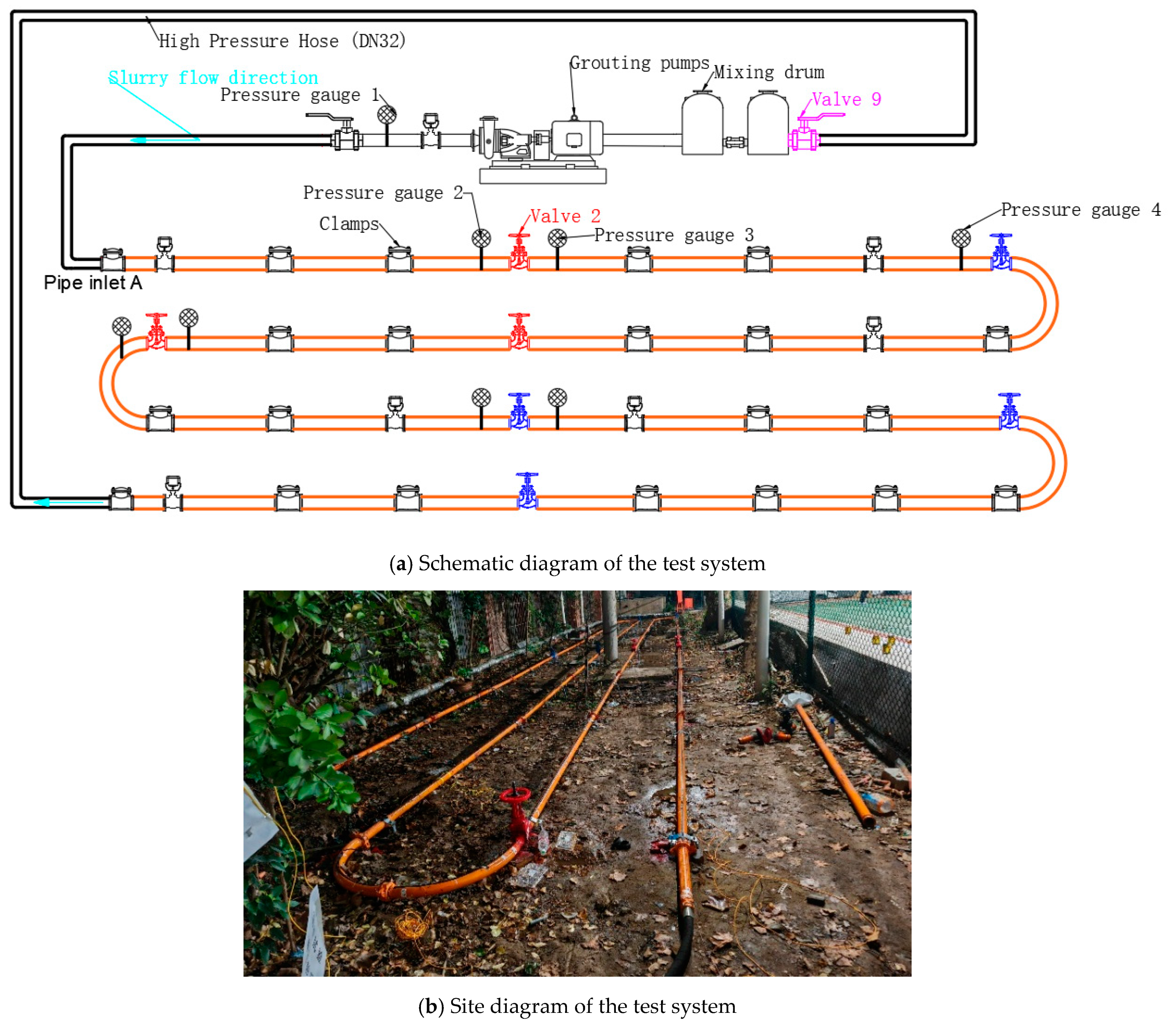
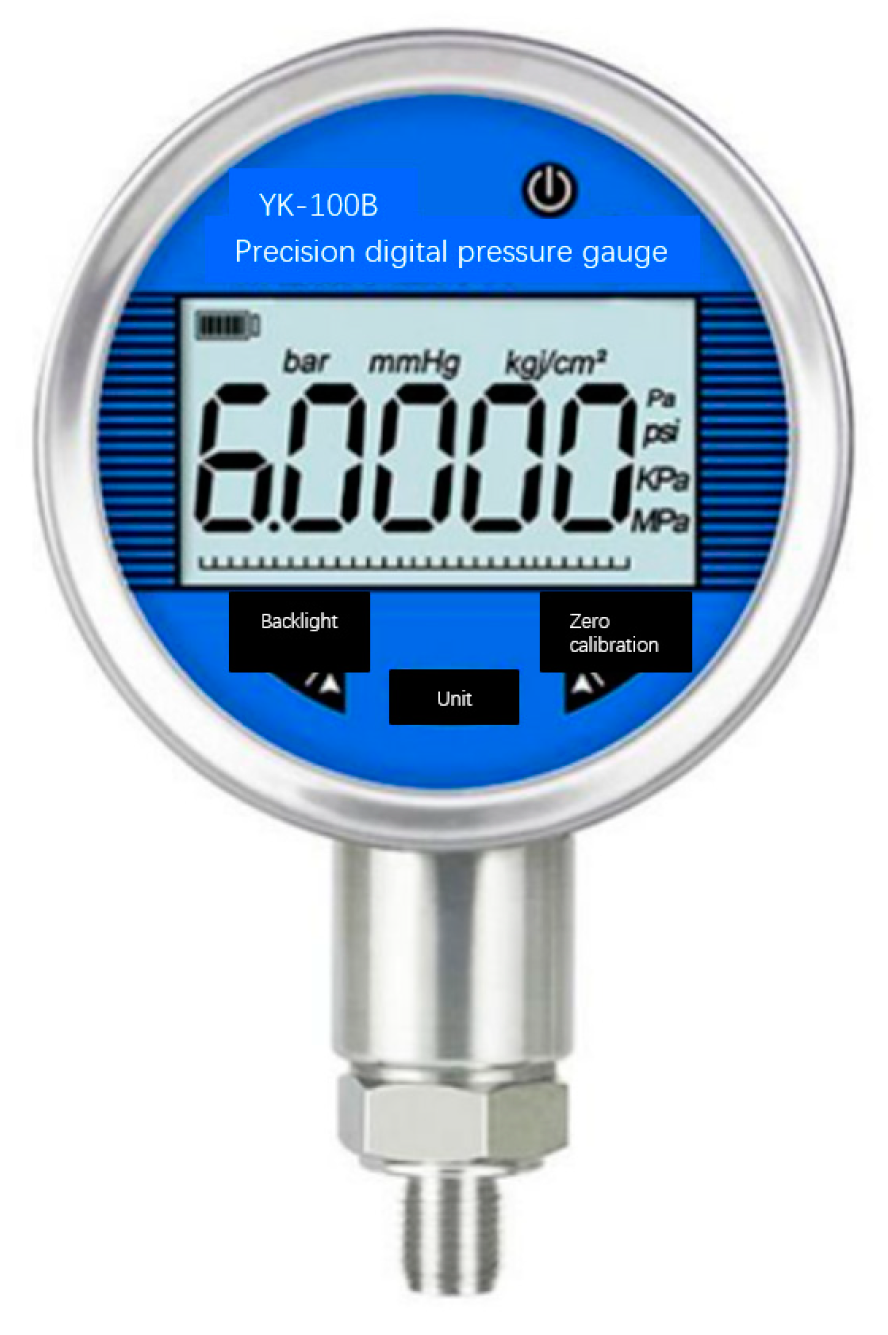
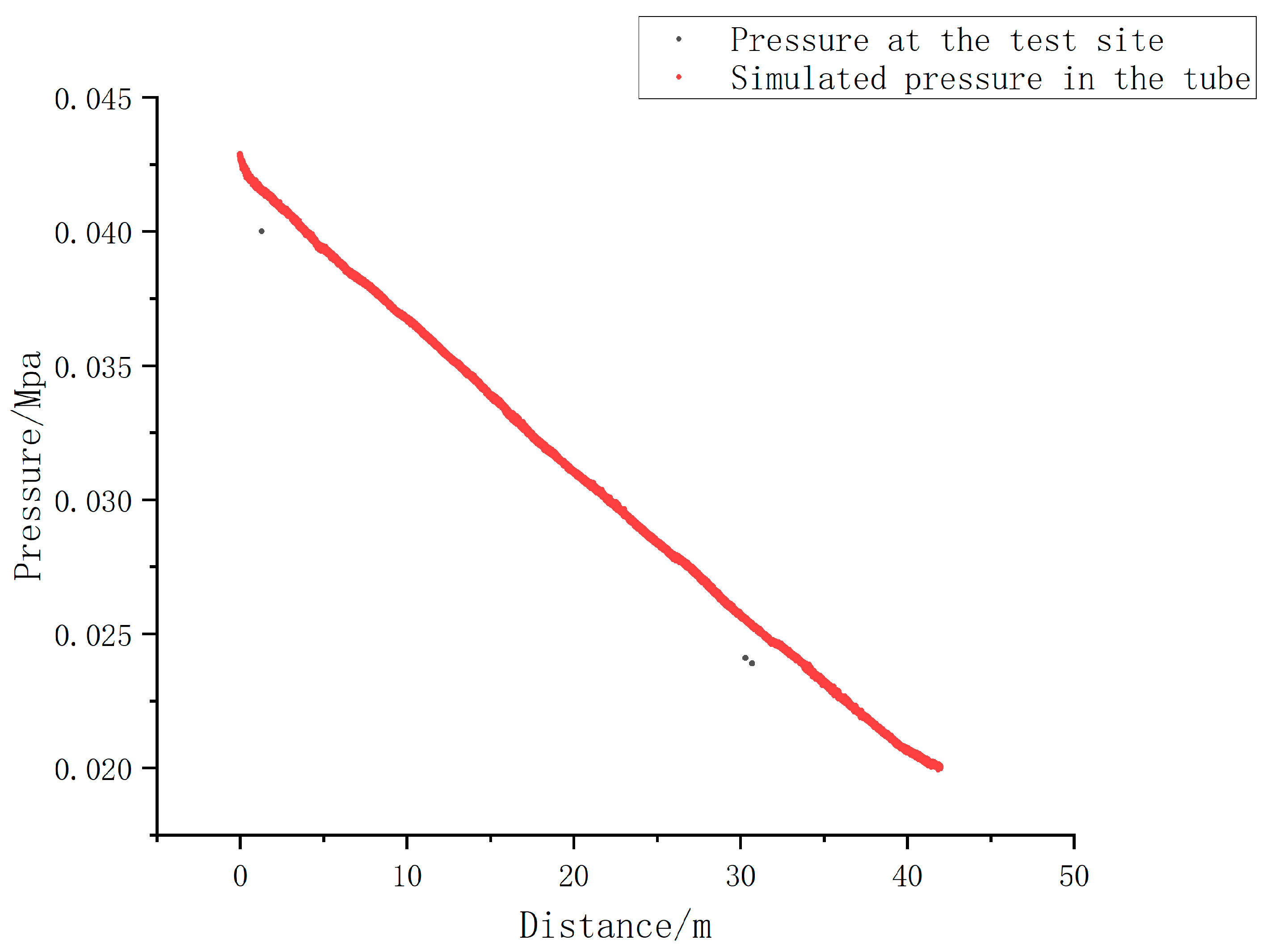
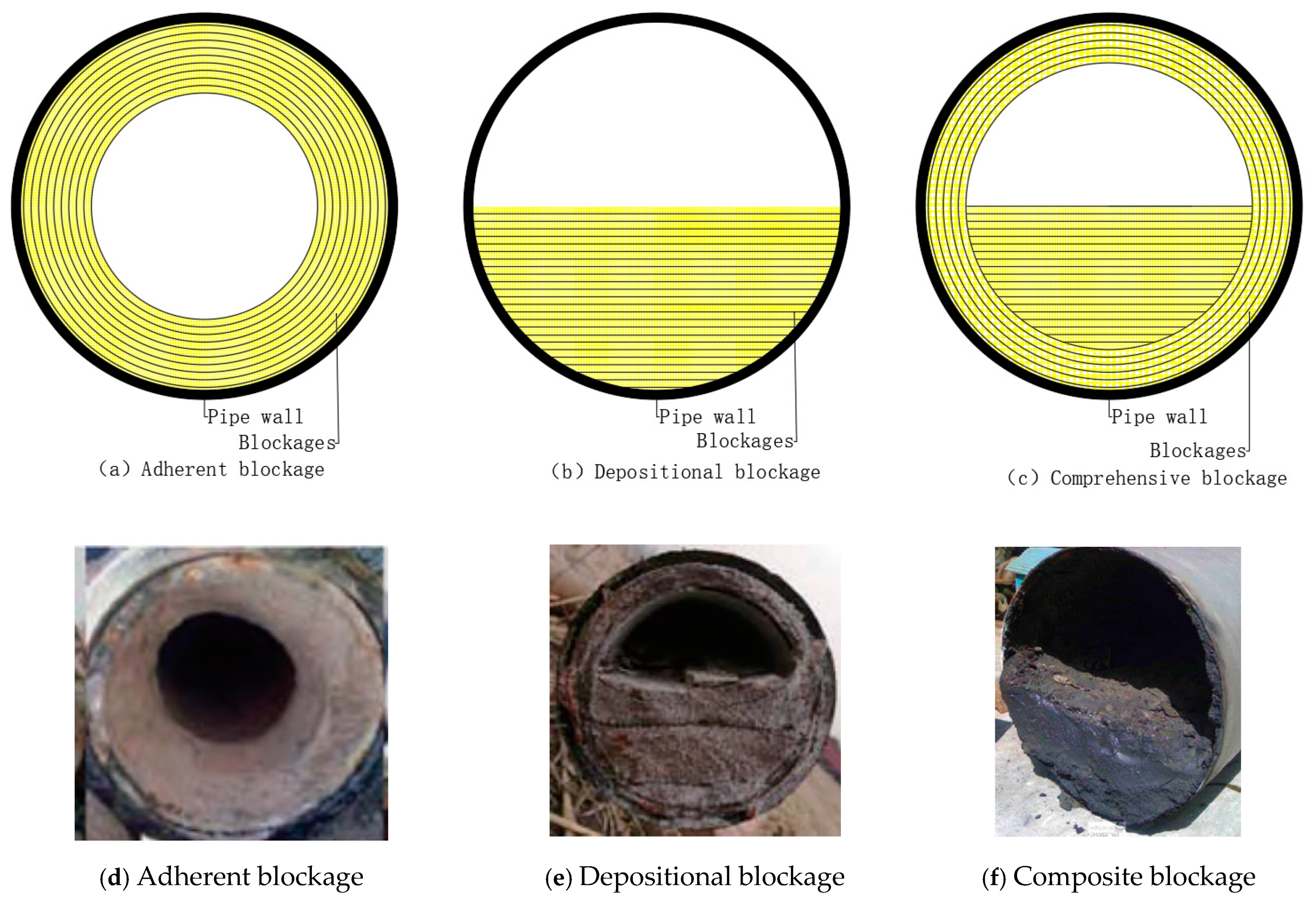


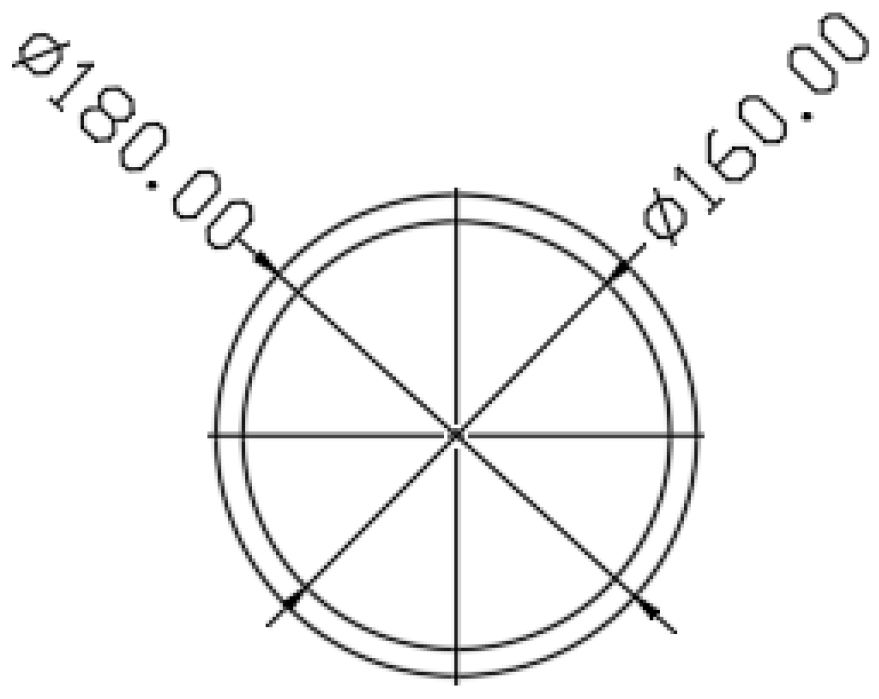


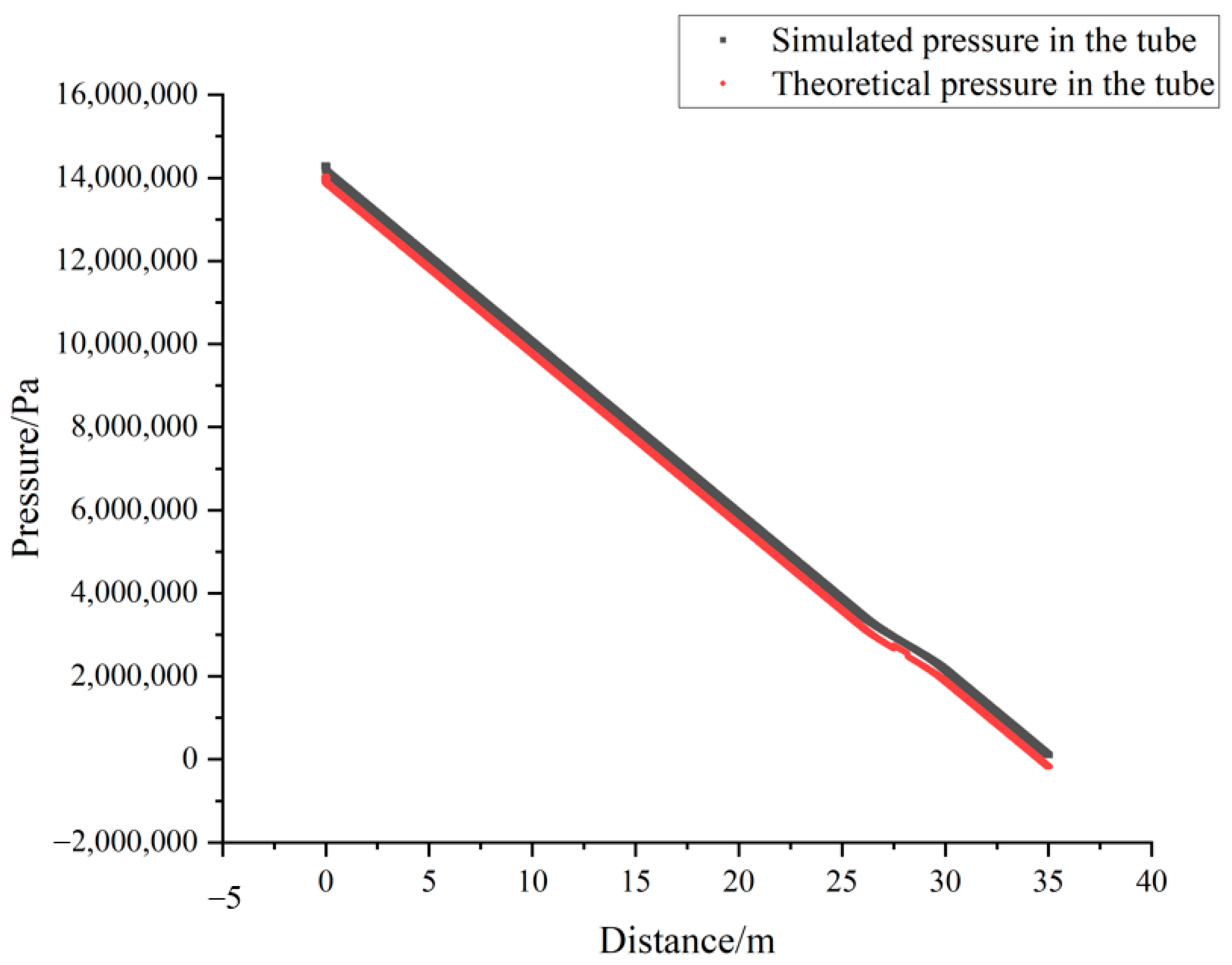
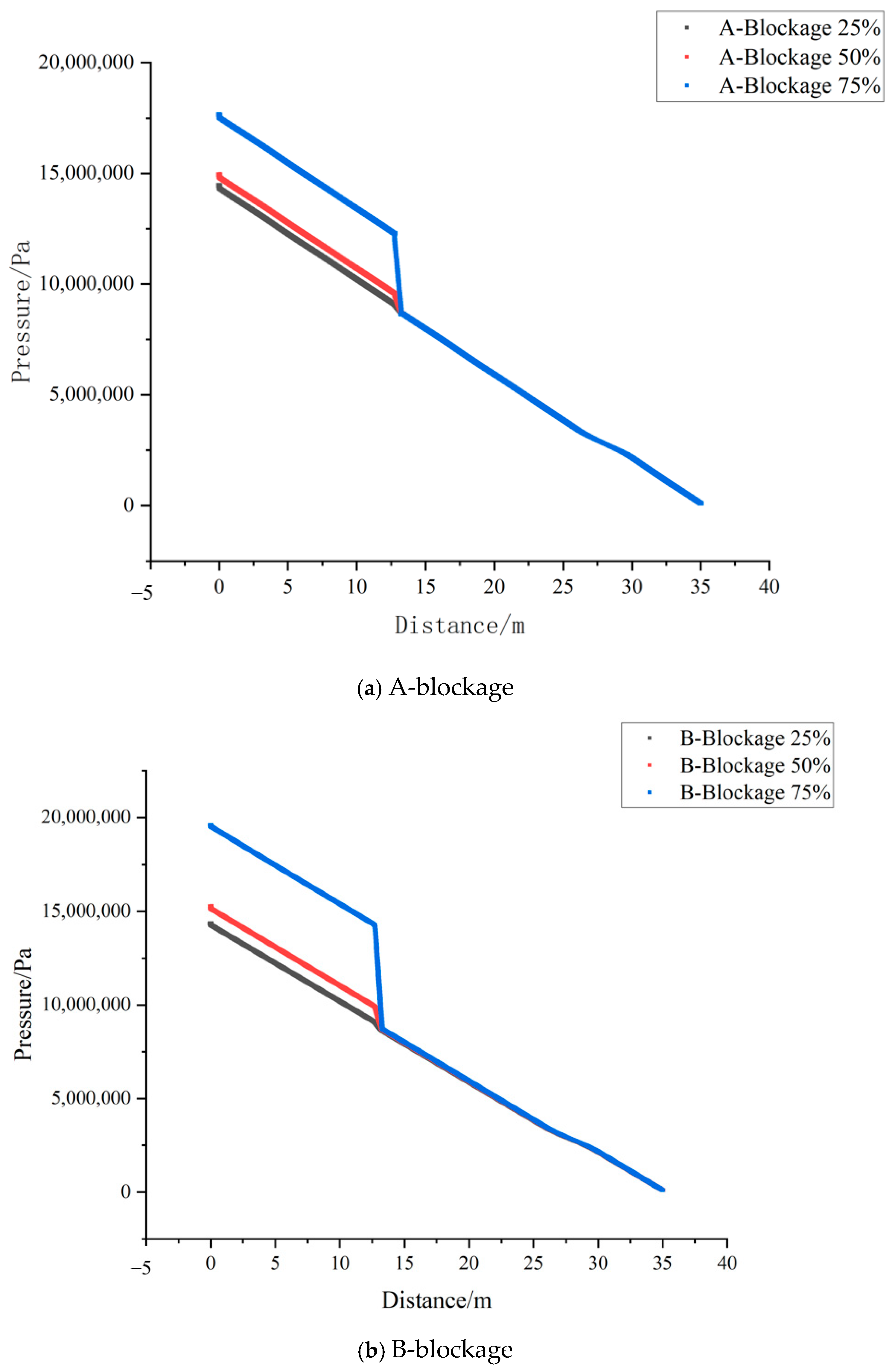

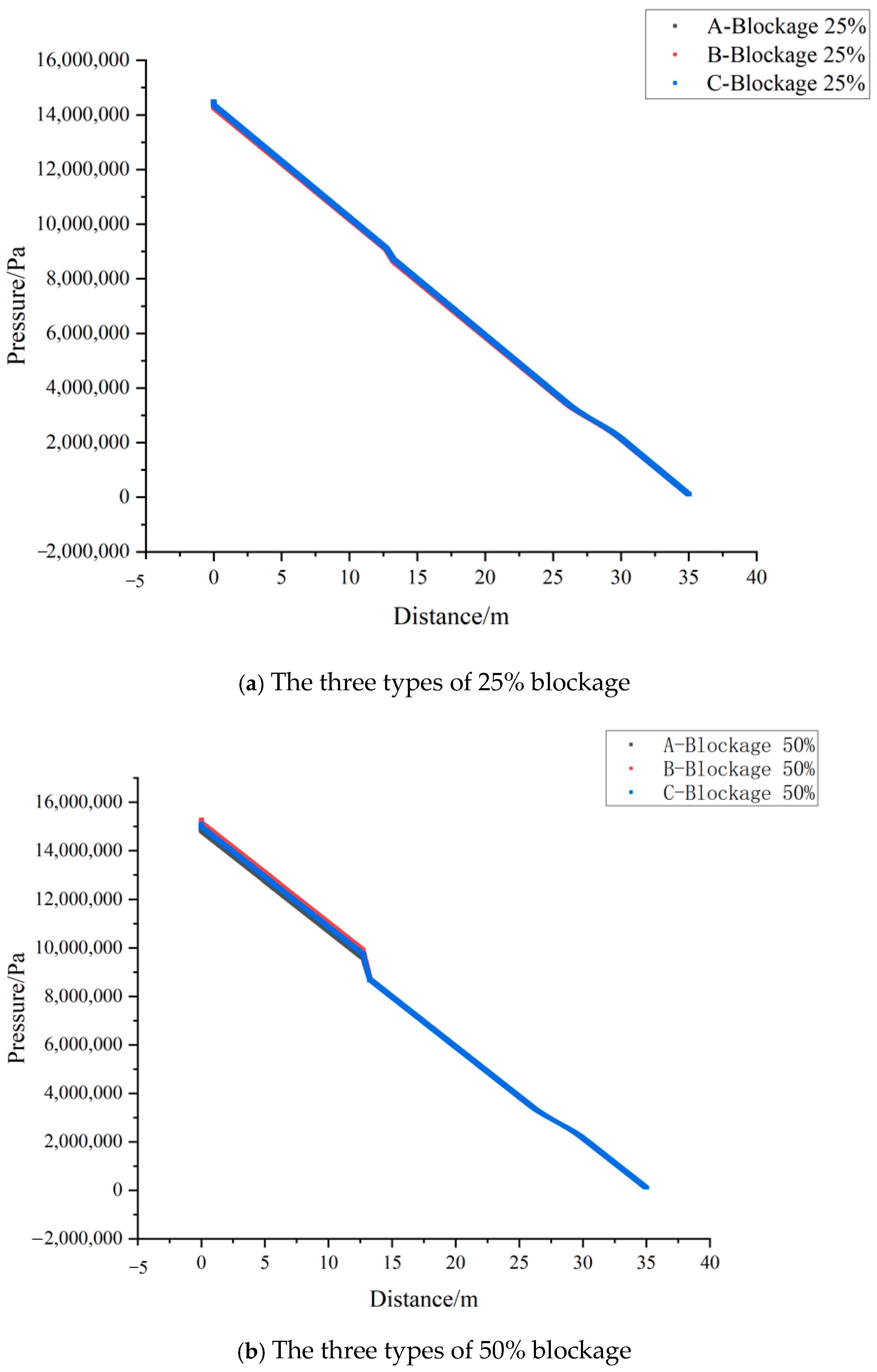
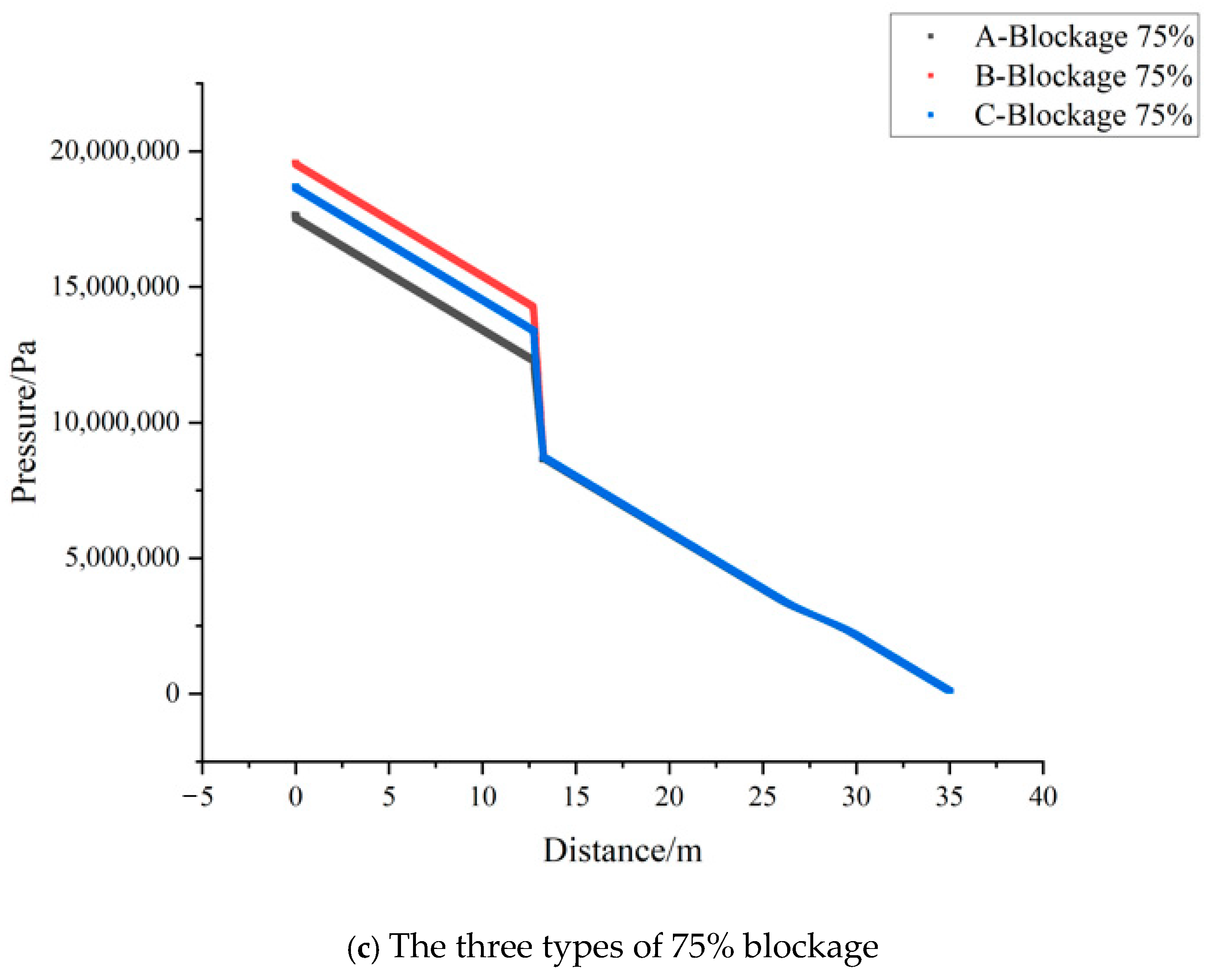



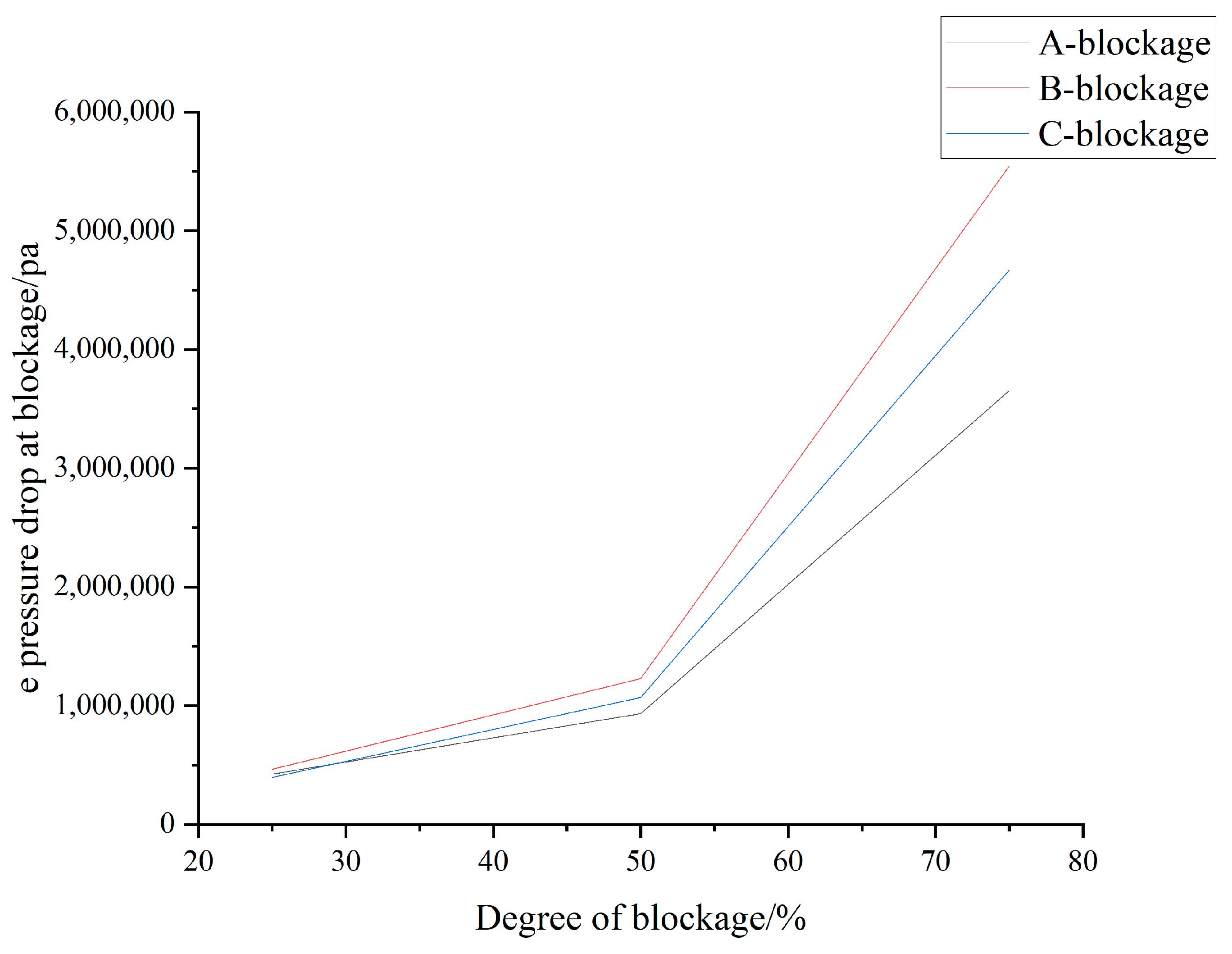
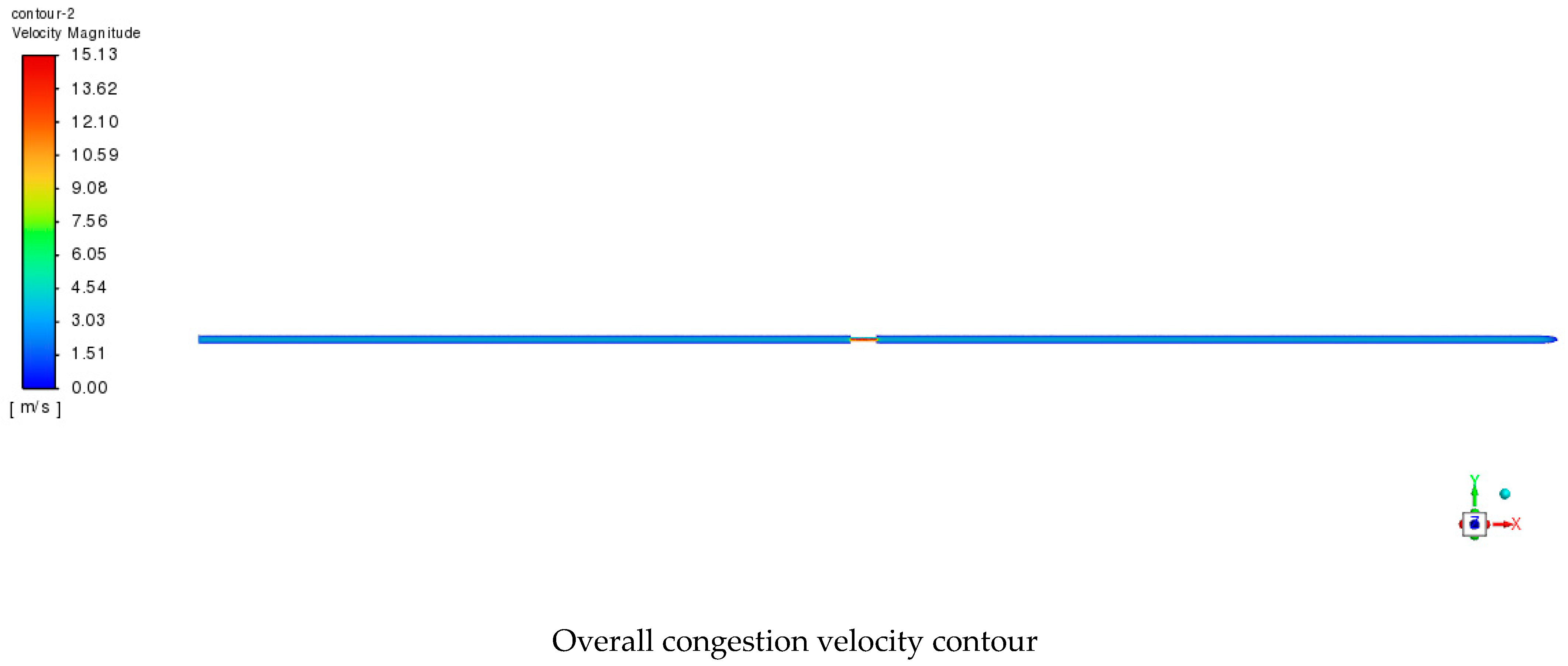



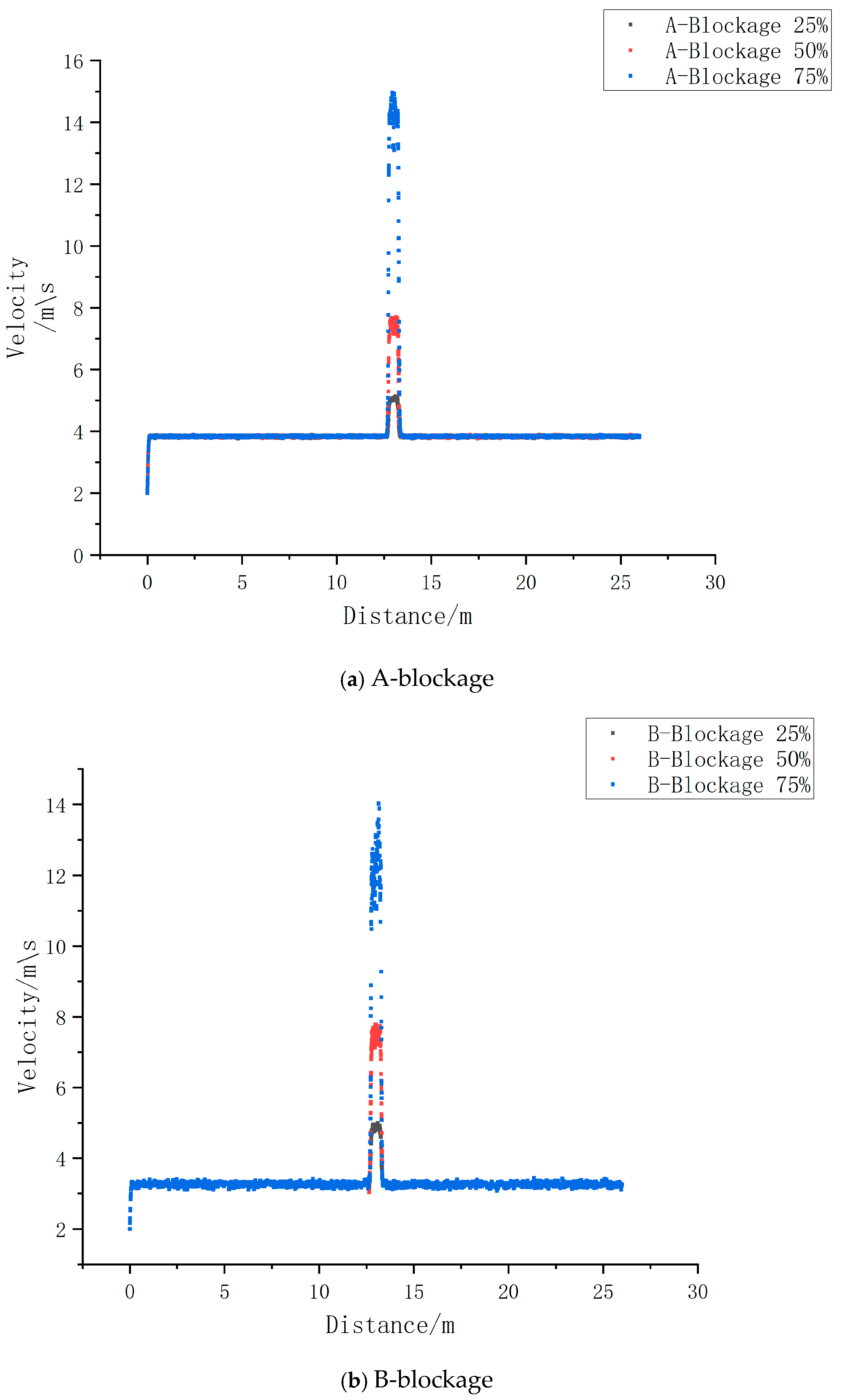
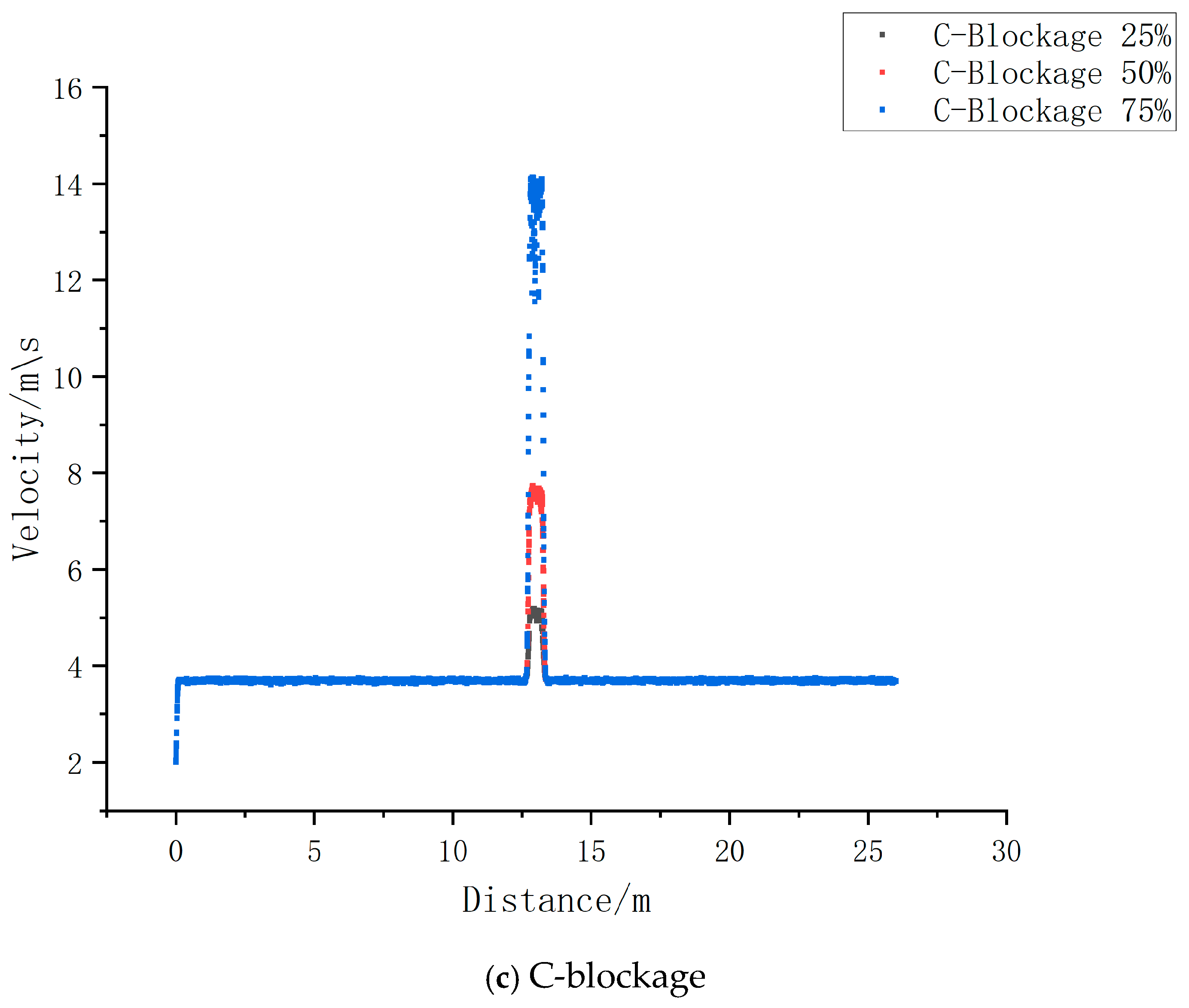
| Case Number | The Degree of Blockage | Blockage Pattern | Blockage Location/m |
|---|---|---|---|
| 1 | 0% | not | 0 |
| 2–7 | 25% | A, B, and C blockages | 13.0 The center of the elbow |
| 8–13 | 50% | A, B, and C blockages | 13.0 The center of the elbow |
| 14–19 | 75% | A, B, and C blockages | 13.0 The center of the elbow |
| Blockage Type | Pressure Drop at 25% Blockage (pa) | Pressure Drop at 25% Blockage (pa) | Pressure Drop at 25% Blockage (pa) |
|---|---|---|---|
| A-blockage | 424,500 | 932,270 | 3,652,260 |
| B-blockage | 464,150 | 1,229,830 | 5,542,770 |
| C-blockage | 397,240 | 1,069,050 | 4,669,570 |
Disclaimer/Publisher’s Note: The statements, opinions and data contained in all publications are solely those of the individual author(s) and contributor(s) and not of MDPI and/or the editor(s). MDPI and/or the editor(s) disclaim responsibility for any injury to people or property resulting from any ideas, methods, instructions or products referred to in the content. |
© 2025 by the authors. Licensee MDPI, Basel, Switzerland. This article is an open access article distributed under the terms and conditions of the Creative Commons Attribution (CC BY) license (https://creativecommons.org/licenses/by/4.0/).
Share and Cite
Zhu, L.; Li, Z.; Wu, Y.; Liu, C.; Zhang, D.; Chai, J.; Gu, W.; Ding, Z.; Gao, L.; Qiu, F.; et al. CFD Numerical Simulation of Slurry Flow Characteristics Under the Clogged Form of Coal Gangue Slurry Transportation Pipeline. Appl. Sci. 2025, 15, 1957. https://doi.org/10.3390/app15041957
Zhu L, Li Z, Wu Y, Liu C, Zhang D, Chai J, Gu W, Ding Z, Gao L, Qiu F, et al. CFD Numerical Simulation of Slurry Flow Characteristics Under the Clogged Form of Coal Gangue Slurry Transportation Pipeline. Applied Sciences. 2025; 15(4):1957. https://doi.org/10.3390/app15041957
Chicago/Turabian StyleZhu, Lei, Zhi Li, Yuyi Wu, Chengyong Liu, Dingding Zhang, Jing Chai, Wenzhe Gu, Ziwei Ding, Lei Gao, Fengqi Qiu, and et al. 2025. "CFD Numerical Simulation of Slurry Flow Characteristics Under the Clogged Form of Coal Gangue Slurry Transportation Pipeline" Applied Sciences 15, no. 4: 1957. https://doi.org/10.3390/app15041957
APA StyleZhu, L., Li, Z., Wu, Y., Liu, C., Zhang, D., Chai, J., Gu, W., Ding, Z., Gao, L., Qiu, F., & Ma, C. (2025). CFD Numerical Simulation of Slurry Flow Characteristics Under the Clogged Form of Coal Gangue Slurry Transportation Pipeline. Applied Sciences, 15(4), 1957. https://doi.org/10.3390/app15041957






